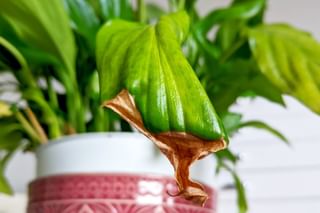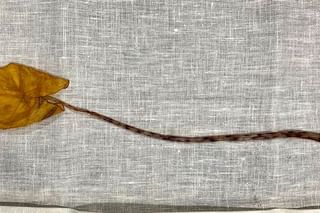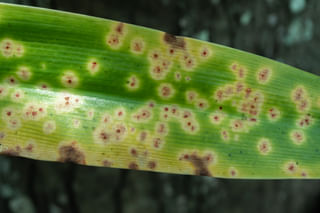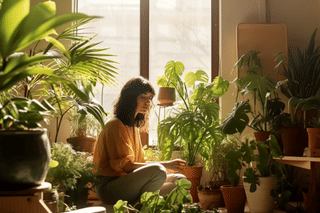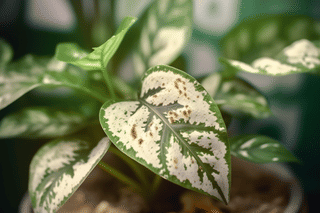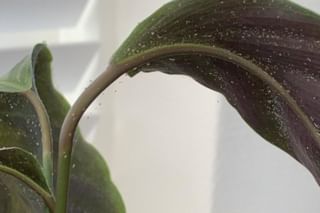What is wrong with my plant? 10 common problems explained!
Your plant can be a mystery at times. One day it's doing well and the next it's struggling. If you've experienced this before you know that finding out what's wrong is not easy. The symptoms your plant is showing can mean a lot of different things. It's difficult to deal with this. Luckily there is a way out!
Photo by Vadim kaipov on Unsplash
Your plant can be a mystery at times. One day it's doing well and the next it's struggling. If you've experienced this before you know that finding out what's wrong is not always easy. The symptoms your plant is showing can mean a lot of different things, which makes it difficult. Luckily there is a solution!
In this guide, we'll walk through each of the possible symptoms. I'll explain what these symptoms mean and how you can help your plant to recover.
These are the symptoms we're going to look at together:
- Yellow leaves
- Brown tips or edges of leaves
- Only bottom leaves turn yellow
- Leaves suddenly fall off
- Plant starts to wilt
- Spots on leaves
- Leaves get yellow speckling
- Sticky leaves
- Plant suddenly stops growing
- Smaller than normal leaves
These are the most common symptoms that a plant might show.
How to use this guide
Before we get started, it's good to realize that most of these symptoms can have multiple causes. So how do you find out what's wrong? Well, you look at each of the causes and start to rule them out.
For example You have the following possible problems: root rot, nutrient deficiency, and not enough sunlight. If you know that your plant is getting plenty of sunlight and doesn't suffer from root rot you only have one option left: nutrient deficiency. When you rule out possible causes in this way you can quickly find out what's wrong with your plant.
Let's get into the symptoms, what's causing them, and how you can help your plant recover.
Symptoms: What does your plant show?
Photo by Gaelle Marcel on Unsplash
Symptoms can be confusing at times because they can mean a lot of different things. When you're looking at what could be wrong with your plant, carefully look at each of the possible causes we mention. This way you can find out what your plant is going through and how to help it.
Let's get into the specific symptoms your plants might show!
1. Yellow leaves

Yellowing leaves are one of the most common symptoms your plant can show when it's struggling. When the leaves of your houseplant start to turn yellow, this could mean 4 different things:
- Your plant has root rot
- Your plant is not getting enough sunlight
- Your plant has a nutrient deficiency
- Your plant is root-bound
The most common causes are root rot or improper sunlight. Nutrient deficiency and your plant being root-bound are less likely but could be what's troubling your plant too.
2. Brown tips or edges of leaves
Brown tips on your houseplants are a scary sight. Your plant will shrivel up and it looks like it's dying. Luckily, this is not the case most of the time. When you catch your plant turning brown early on, you can still help it recover.
Your houseplant might get brown tips or edges on its leaves when:
- The air is too hot or dry
- There is too much salt in the soil
- Your plant has a nutrient deficiency
- Your plant has root rot
Brown tips are usually a sign that your plant is too dry. This doesn't mean that you should water it more though. Sometimes watering your plant too much could cause the tips of leaves to turn brown, turning into root rot.
Start by checking if your plant might be in a spot that's too warm for it. If that's not the case, you can look at your watering habits. If the soil is dry, it might be time to water it and adjust your watering schedule.
3. Only bottom leaves turn yellow
Sometimes your plant's leaves might turn yellow, but not all of them. If you see the bottom leaves turning yellow or falling off, it could be because:
- Your plant is aging
- Your plant has a nutrient deficiency
- Your plant is root-bound
When some plants get older and don't replace stems and leaves, like Crotons, they will start to drop their leaves. This is not a problem, but it's a natural thing to happen. These plants don't have a problem, and will still grow leaves on newer parts of their stems.
If your plant doesn't have enough space or energy to grow, it could also start to drop leaves. This could be your plant showing you that it needs to be repotted or fed.
4. Leaves suddenly fall off
It's a scary thing when your plant suddenly starts to drop its leaves. It's often after you've suddenly changed something in your plant's environment. If your plant starts to drop its leaves, it could be because:
If you've recently moved your plant to another place, it could be in shock. Most plants have no problem with this, but others like Calatheas don't like change. These types of plants need to settle into their new environment before they can thrive again.
5. The plant starts to wilt

One of the easiest symptoms to figure out is when your plant starts to wilt. This is quite an easy symptom to find out because it's all because of water issues. Your plant starts to wilt when:
Finding which one your plant is dealing with is easy. If you haven't watered your plant in at least a week and the soil is dry, your plant is thirsty. If you've recently watered your houseplant and the soil is moist, your plant might be suffering from root rot.
6. Spots on leaves
Some plants are sensitive to certain types of fungal infections. These infections show up as spots on your plant's leaves. The first thing to do when you see these spots is to separate this plant from your other plants. The last thing you want is for the infection to spread to other plants.
Now that your plant is in a safe spot, you can figure out which of these two things you're dealing with:
Water spots are less likely to happen and only appear in a few plants, so check for fungal infections first. You'll need to move quickly to fix this problem because if it doesn't get better soon, your plant might not make it. It's best to use fungicides or natural solutions like neem oil to save your plant. If you're planting outside, you can use copper soap instead.
7. Leaves get yellow speckling
If your plant starts to get yellow spots and you can see cobwebs, you're dealing with Spider mites. Spider mites are a very common pest that affects a lot of different plants. Luckily, it's not difficult to help your plant recover from it. These are all the symptoms you can use to tell if your plant has spider mites:
- The leaves have yellow speckling
- You see some webbing on the tips of the stems
- It starts to wilt or turn brown and crispy
To get rid of these pests, you can use a mix of water and alcohol to spray on your plant. You can also use an insecticidal spray on your plant.
8. Sticky leaves

Another pest, like the Spider mites, are Mealy bugs and scale. When your plant is suffering from these pests you'll know by feeling the leaves. When your plant is suffering from this pest, the leaves will be sticky and you might see small cotton fluffs or brown spots. Like any other pest, you can help your plant recover when you catch the pest early on. If you leave it around for weeks, you might not be able to help it recover anymore.
9. The plant suddenly stops growing
If you've kept plants for a longer period, you might have noticed that some plants seem to stop growing out of nowhere. This is no problem if it's currently autumn (fall) or winter because this is normal. However, if it's currently spring or summer, there might be a problem. Your plant might have stopped growing because of:
The most common problem is root rot, but nutrient deficiency and not having enough space to grow are also possibilities. Make sure to check if your plant has root rot first, as this could harm your plant. If that's not the case, you might need to fertilize or repot your plant.
10. Smaller than normal leaves
If your plant is growing well during the spring and summer everything is as it should be. However, when your plant starts to put out small leaves that aren't as big as they should be, you might have a problem.
When your plant starts to grow leaves that are smaller than normal, it might be because:
- Your plant has root rot
- Your plant has a nutrient deficiency
- Your plant is not getting enough sunlight
- Your plant is root-bound
Your houseplant either can't grow bigger because it doesn't have enough energy or space. When your plant doesn't have enough space to grow, growth isn't promoted and your plant will stay small. When your plant doesn't have enough nutrition it can also stop growing larger leaves.
To fix this, check if your plant has root rot. If that's the case, remove affected roots and repot in fresh soil. Also, make sure to fertilize once a month or more often if needed.
Causes: Why is this happening?
We've looked at the most common symptoms and what these could mean. There are several reasons why your plant may be showing these symptoms. It could be because of environmental factors such as too much or too little water, lack of sunlight, or changes in temperature and humidity. Your plant's health can also be affected by pests, diseases, and nutrient deficiencies.
Let's find out why your plant is showing these symptoms and how you can help your plant out.
Root rot

Root rot is a tough thing to deal with when it comes to houseplants. Root rot happens when your plant doesn't get enough oxygen to its roots. This usually happens when you accidentally overwater your plants over a longer time.
If you water your plant too much once there is no problem. Your plant will recover from this. However, if your plant consistently gets too much water, the soil can't get oxygen to your plant's roots. When this happens, the roots start to rot and you're at risk of losing your plant.
Luckily, if you catch this early on, you can rescue your plant. The very first thing to do is make sure your plant is in dry soil. You can do this by letting the soil dry out or in the worst-case scenario repot your plant. If this doesn't work, you can try to rescue your plant using Leca: What is Leca and why is it useful for plants?. If that also doesn't work, you can always try to propagate your plant. If you want to find out more about this, make sure to read How to rescue a plant from overwatering.
Not enough sunlight
A lot of plants love sunlight, especially brightly colored plants with beautiful patterns. When these brightly colored plants don't get enough sunlight, their leaves will turn yellow or pale. When you see this happen to your plant, it's time to move it to a spot that's a little bit brighter.
When you move your plant to a brighter spot, make sure to do this gradually. Most plants deal with change quite well, but there are a few that need some time to settle in. So when you move your plant from a darker place to a brighter place, do this slowly.
The pale leaves might turn back to their original color, but it doesn't always happen. The yellow leaves, on the other hand, will stay yellow. You can trim these leaves and wait for new leaves to grow. These new leaves should have the original color if your plant is getting the right amount of sunlight.
Too little water

A thirsty plant is often easy to spot. These plants will start to droop and their leaves won't look as shiny as they used to. This is often not harmful to your plant unless you forget to water your plant after it starts to wilt.
You can help your plant recover by watering it. Most plants will recover within a matter of hours. They'll look just as good as they did before and it will look like nothing was wrong at all.
Nutrient deficiency
Your houseplant needs energy to grow big and strong. If it doesn't get enough energy from the soil to grow, it won't grow as quickly or it may turn pale. When this happens, you'll need to give your plant some extra nutrients to grow.
You can do this by fertilizing your plant. When you fertilize your plant, you give it the important nutrients it needs to grow and recover from any harm. After you've fertilized your plant, it should return to normal within a few days. If you'd like to know more about fertilizing your houseplant, read What is the best type of fertilizer for houseplants?.
Plant is root-bound

Some plants grow very quickly, while others take a while longer. It's important to regularly repot your plants to give them enough space to keep growing. If you don't repot your houseplant in time, its roots will become too big for the pot it's currently in.
You know it's time to repot your plant when the roots start to circle the bottom of the pot or if you see more roots than soil. Repot your plant in a pot that's about 5 cm (2 inches) bigger than the pot it's currently in. This way you're not putting your plant in a pot that's too large. If your plant is in a pot that's too large, it's easy to overwater your plant and cause root rot.
Hot or dry air
Hot or dry air is great for some plants but terrible for others. Your tropical plants love humidity and dry air is their biggest fear. Plants like the Calathea need humidity to thrive and dry air will turn their leaves brown and crispy.
Luckily, there are several ways of fixing this problem. First of all, make sure that your plant isn't exposed to direct sunlight. When you move your plant away from direct sunlight, you're also moving it away from hot air.
The second step is to raise the humidity in the air for your houseplant. There are several amazing ways to do this, including: misting your plants, using a humidifier, and placing your plant on a pebble tray. If you'd like to find more ideas on how to raise the humidity for your houseplants, you can read 10 ways to raise the humidity in your house. In that guide, we'll explore 10 ways to raise the humidity in your house to help your tropical plants thrive.
Too much salt in the soil
If you've taken care of plants for a little while, you might have heard or read somewhere that you shouldn't use tap water for your plants. There is some truth in that statement. When you use unfiltered tap water to water your plants, you're exposing your plants to the calcium in your water lines. This is not a problem if you do it once. But if you do this consistently, the soil of your plant will have more calcium in it every time you water your plant. You can see this salt built up in the soil, as it looks like a thin white crust.
Luckily, there are two easy ways to prevent this from happening. The first solution is to only use distilled water to water your plants. This might not be an option for you, so there is another way. You can use tap water, but make sure that you let it sit in your watering can for at least 24 hours before watering your plant. When you wait 24 hours, the salts will sink to the bottom of the watering can. This way your plant won't be exposed to the salts in your tap water.
When you do see the extra salt in the soil, it's easy to get rid of. You can get rid of it by generously watering your plant with "clean" water and letting it drain out of the bottom of the pot.
Your plant is in shock
You can put your plants into shock by exposing them to sudden changes. For example: moving them from a dark place to a very bright place. Not all plants can deal with this sudden change and they'll need to settle in for a few weeks. When your plants are trying to settle in, they go into survival mode and do everything they can to not die. This includes dropping leaves and stems to preserve the energy they need to stay alive.
To avoid this situation, you should make gradual changes to your plant's environment. If your plant is currently in shock, do nothing. Let your plant adjust at its own pace. If you move your plant again, it might stay in shock for longer and that could kill it. It's a scary thing to happen to any plant owner, whether you're an experienced or a beginning plant owner.
Fungal infection
Fungal infections aren't very common, but they are most common in plants that you bought recently. This is why it's important to keep your new plants separate from your other plants for the first few weeks. The last thing you want is for any fungal diseases to accidentally spread to the rest of your plants.
You can prevent any fungal infections on your plant by making sure the leaves of your plant stay dry. Fungi need moisture to develop, so when you don't give it moisture, it can't develop. When you see black spots on your plant's leaves, cut those leaves off to prevent spreading.
Water spots
Water spots aren't a very common thing among houseplants and only show up on a few plants. Water spots are caused by cold water touching the leaves of a few specific plants.
You can prevent these water spots by making sure cold water never touches the leaves of your plant. If your plant is already dealing with water spots, you can trim those leaves.
Pruning your plant doesn't hurt your plant and gives it back some energy to continue growing. Pruning your houseplants: Why you shouldn't be afraid to do it will tell you more about pruning and its benefits.
Spider mites
Spider mites are a tough and common pest on a lot of different houseplants. When your plant is dealing with spider mites, you'll often see yellow spots on your plant's leaves. Most of the time, you will also see cobwebs.
You can deal with spider mites by using soapy water to drown them. Another great way to deal with spider mites is using a neem oil mixture. Neem oil will kill the spider mites in a matter of days and will also make sure they don't come back soon. Using soapy water or neem oil to clean your plant's leaves will get rid of spider mites easily.
If you want to read more about spider mites, have a look at How to get rid of spider mites on your houseplants.
Mealybugs or scale insects
Mealy bugs and scale insects are very sneaky pests that will infect your plant quickly. They look like white cotton balls on your plant. They often show up through new plants, come from outside, or even from some fruit.
You can prevent mealybugs from getting to your plants by keeping your plants away from any fruit, not bringing them outside, and keeping new plants away from your collection for a few weeks. If you're already dealing with mealybugs, keep the infected plant away from your other plants. You can then treat the pest by using a cotton swab dipped in rubbing alcohol. Touch the mealybugs with the cotton swab and they will die quickly.
Another way to get rid of mealybugs is using Neem oil. Prepare a spray bottle with water, soap, and Neem oil mixture, then spray your plant thoroughly. This will kill the pests within a few days.
If you want to read more about spider mites, have a look at How to use Neem Oil with plants.
Conclusion
In this guide, we've looked at 10 different symptoms that could be impacting your houseplants, ranging from salt build-up and shock to fungal infections, water spots, and pests. These symptoms could mean a lot of different things, and luckily they all have possible solutions.
It's important to remember that understanding and patience are important- finding your plant's problems can be a process of elimination but when you use this guide, you can figure out what's wrong with your plant and how you can help it recover.
Thank you for reading this post! I hope it helps you to keep your plants healthy and beautiful! If you're looking for more guides on specific plants, you can always request a plant guide to get a guide for the plant you have trouble with.
Test your plant care knowledge
Quiz completed!
Want to learn more? Sign up for my newsletter to receive free tips in your inbox!
Sign up now!

